Enhanced Reversible Magnetic-Field-Induced Strain in Ni-Mn-Ga Alloy
Abstract
:1. Introduction
2. Phase-Field Model
3. Results
4. Conclusions
Author Contributions
Funding
Institutional Review Board Statement
Informed Consent Statement
Data Availability Statement
Conflicts of Interest
References
- O’Handley, R.C.; Murray, S.J.; Marioni, M.; Nembach, N.; Allen, S.M. Phenomenology of giant magneticfield-induced strain in ferromagnetic shape-memory materials (invited). J. Appl. Phys. 2000, 87, 4712–4717. [Google Scholar] [CrossRef]
- Ma, J.; Karaman, I.; Noebe, R.D. High temperature shape memory alloys. Int. Mater. Rev. 2013, 55, 257–315. [Google Scholar] [CrossRef]
- Li, Z.; Hu, W.; Chen, F.; Zhang, M.; Li, Z.; Yang, B.; Zhao, X.; Zuo, L. Large magnetoresistance in a directionally solidified Ni44.5Co5.1Mn37.1In13.3 magnetic shape memory alloy. J. Magn. Magn. Mater. 2018, 452, 249–252. [Google Scholar] [CrossRef]
- Cheng, P.; Zhou, Z.; Chen, J.; Li, Z.; Yang, B.; Xu, K.; Li, Z.; Li, J.; Zhang, Z.; Wang, D.; et al. Combining magnetocaloric and elastocaloric effects in a Ni45Co5Mn37In13 alloy. J. Mater. Sci. Technol. 2021, 94, 47–52. [Google Scholar] [CrossRef]
- Heczko, O.; Straka, L. Temperature dependence and temperature limits of magnetic shape memory effect. J. Appl. Phys. 2003, 94, 7139–7143. [Google Scholar] [CrossRef] [Green Version]
- Liang, T.; Jiang, C.B.; Xu, H.B.; Liu, Z.H.; Zhang, M.; Cui, Y.T.; Wu, G.H. Phase transition strain and large magnetic field induced strain in Ni50.5Mn24Ga25.5 unidirectionally solidified alloy. J. Magn. Magn. Mater. 2004, 268, 29–32. [Google Scholar] [CrossRef]
- Karaca, H.; Karaman, I.; Basaran, B.; Chumlyakov, Y.; Maier, H. Magnetic field and stress induced martensite reorientation in NiMnGa ferromagnetic shape memory alloy single crystals. Acta Mater. 2006, 54, 233–245. [Google Scholar] [CrossRef]
- Pagounis, E.; Chulist, R.; Szczerba, M.J.; Laufenberg, M. Over 7% magnetic field-induced strain in a Ni-Mn-Ga five-layered martensite. Appl. Phys. Lett. 2014, 105, 052405. [Google Scholar] [CrossRef]
- Sozinov, A.; Lanska, N.; Soroka, A.; Zou, W. 12% magnetic field-induced strain in Ni-Mn-Ga-based non-modulated martensite. Appl. Phys. Lett. 2013, 102, 021902. [Google Scholar] [CrossRef]
- Chernenko, V.A.; L’vov, V.; Pons, J.; Cesari, E. Superelasticity in high-temperature Ni–Mn–Ga alloys. J. Appl. Phys. 2003, 93, 2394–2399. [Google Scholar] [CrossRef]
- Chen, H.; Wang, Y.D.; Nie, Z.; Li, R.; Cong, D.; Liu, W.; Ye, F.; Liu, Y.; Cao, P.; Tian, F.; et al. Unprecedented non-hysteretic superelasticity of [001]-oriented NiCoFeGa single crystals. Nat. Mater. 2020, 19, 712–718. [Google Scholar] [CrossRef]
- Ge, Y.; Heczko, O.; Söderberg, O.; Lindroos, V.K. Various magnetic domain structures in a Ni–Mn–Ga martensite exhibiting magnetic shape memory effect. J. Appl. Phys. 2004, 96, 2159–2163. [Google Scholar] [CrossRef] [Green Version]
- Zhang, J.X.; Chen, L.Q. Phase-field model for ferromagnetic shape-memory alloys. Philos. Mag. Lett. 2005, 85, 533–541. [Google Scholar] [CrossRef]
- Chmielus, M.; Zhang, X.X.; Witherspoon, C.; Dunand, D.C.; Mullner, P. Giant magnetic-field-induced strains in polycrystalline Ni-Mn-Ga foams. Nat. Mater. 2009, 8, 863–866. [Google Scholar] [CrossRef] [PubMed]
- Dunand, D.C.; Mullner, P. Size effects on magnetic actuation in Ni-Mn-Ga shape-memory alloys. Adv. Mater. 2011, 23, 216–232. [Google Scholar] [CrossRef]
- Wang, Z.L.; Zheng, P.; Nie, Z.H.; Ren, Y.; Wang, Y.D.; Müllner, P.; Dunand, D.C. Superelasticity by reversible variants reorientation in a Ni–Mn–Ga microwire with bamboo grains. Acta Mater. 2015, 99, 373–381. [Google Scholar] [CrossRef] [Green Version]
- Zhou, Z.; Wu, P.; Ma, G.; Yang, B.; Li, Z.; Zhou, T.; Wang, D.; Du, Y. Large reversible magnetic-field-induced strain in a trained Ni49.5Mn28Ga22.5 polycrystalline alloy. J. Alloy. Compd. 2019, 792, 399–404. [Google Scholar] [CrossRef]
- Hua, H.; Wang, J.; Jiang, C.; Xu, H. Large reversible magnetostrain of a Ni30Cu8Co12Mn37Ga13 single crystal. Scr. Mater. 2016, 124, 142–145. [Google Scholar] [CrossRef]
- Yu, S.Y.; Gu, A.J.; Kang, S.S.; Hu, S.J.; Li, Z.C.; Ye, S.T.; Li, H.H.; Sun, J.J.; Hao, R.R. Large reversible magnetostrain in polycrystalline Ni50Mn33In17−xGax. J. Alloy. Compd. 2016, 681, 1–5. [Google Scholar] [CrossRef]
- Zhong, Y.; Zhu, T. Phase-field modeling of martensitic microstructure in NiTi shape memory alloys. Acta Mater. 2014, 75, 337–347. [Google Scholar] [CrossRef]
- Hu, C.; Zhang, Z.; Yang, T.; Li, W.; Chen, L. Phase-field simulation of magnetic microstructure and domain switching in (Tb0.27Dy0.73)Fe2 single crystal. AIP Adv. 2021, 11, 015207. [Google Scholar] [CrossRef]
- Wu, P.P.; Ma, X.Q.; Zhang, J.X.; Chen, L.Q. Phase-field simulations of stress-strain behavior in ferromagnetic shape memory alloy Ni2MnGa. J. Appl. Phys. 2008, 104, 073906. [Google Scholar] [CrossRef]
- Wu, P.P.; Ma, X.Q.; Zhang, J.X.; Chen, L.Q. Phase-field simulations of magnetic field-induced strain in Ni2MnGa ferromagnetic shape memory alloy. Philos. Mag. 2011, 91, 2102–2116. [Google Scholar] [CrossRef]
- Peng, Q.; He, Y.J.; Moumni, Z. A phase-field model on the hysteretic magneto-mechanical behaviors of ferromagnetic shape memory alloy. Acta Mater. 2015, 88, 13–24. [Google Scholar] [CrossRef]
- Ren, X.; Wang, Y.; Zhou, Y.; Zhang, Z.; Wang, D.; Fan, G.; Otsuka, K.; Suzuki, T.; Ji, Y.; Zhang, J.; et al. Strain glass in ferroelastic systems: Premartensitic tweed versus strain glass. Philos. Mag. 2010, 90, 141–157. [Google Scholar] [CrossRef]
- Wang, D.; Wang, Y.; Zhang, Z.; Ren, X. Modeling abnormal strain states in ferroelastic systems: The role of point defects. Phys. Rev. Lett. 2010, 105, 205702. [Google Scholar] [CrossRef] [Green Version]
- Zhang, J.X.; Chen, L.Q. Phase-field microelasticity theory and micromagnetic simulations of domain structures in giant magnetostrictive materials. Acta Materialia 2005, 53, 2845–2855. [Google Scholar] [CrossRef]
- Chen, L.Q.; Shen, J. Applications of semi-implicit Fourier-spectral method to phase-field equations. Comput. Phys. Commun. 1998, 108, 147–158. [Google Scholar] [CrossRef]
- Khachaturyan, A.G. Theory of Structural Transformations in Solids; John Wiley&Sons: New York, NY, USA, 1983. [Google Scholar]
- Tickle, R.; James, R.D. Magnetic and magnetomechanical properties of Ni2MnGa. J. Magn. Magn. Mater. 1999, 195, 627. [Google Scholar] [CrossRef]
- Paul, D.I.; Marquiss, J.; Quattrochi, D. Theory of magnetization: Twin boundary interaction in ferromagnetic shape memory alloys. J. Appl. Phys. 2003, 93, 4561. [Google Scholar] [CrossRef]
- Glavatska, N.; Mogilniy, G.; Glavatsky, I.; Danilkin, S.; Hohlwein, D.; Beskrovnij, A.; Söderberg, O.; Lindroos, V.K. Temperature dependence of martensite structure and its effect on magnetic field induced strain in Ni2MnGa magnetic shape memory alloys. J. Phys. 2003, 112, 963. [Google Scholar] [CrossRef]
- Dai, L.; Cullen, J.; Cui, J.; Wuttig, M. Elasticity study in ferromagnetic shape memory alloys. MRS Proc. 2004, 785. [Google Scholar] [CrossRef]
- Bhattacharyya, S.; Heo, T.W.; Chang, K.; Chen, L.-Q. A phase-field model of stress effect on grain boundary migration. Model. Simul. Mater. Sci. Eng. 2011, 19, 035002. [Google Scholar] [CrossRef]
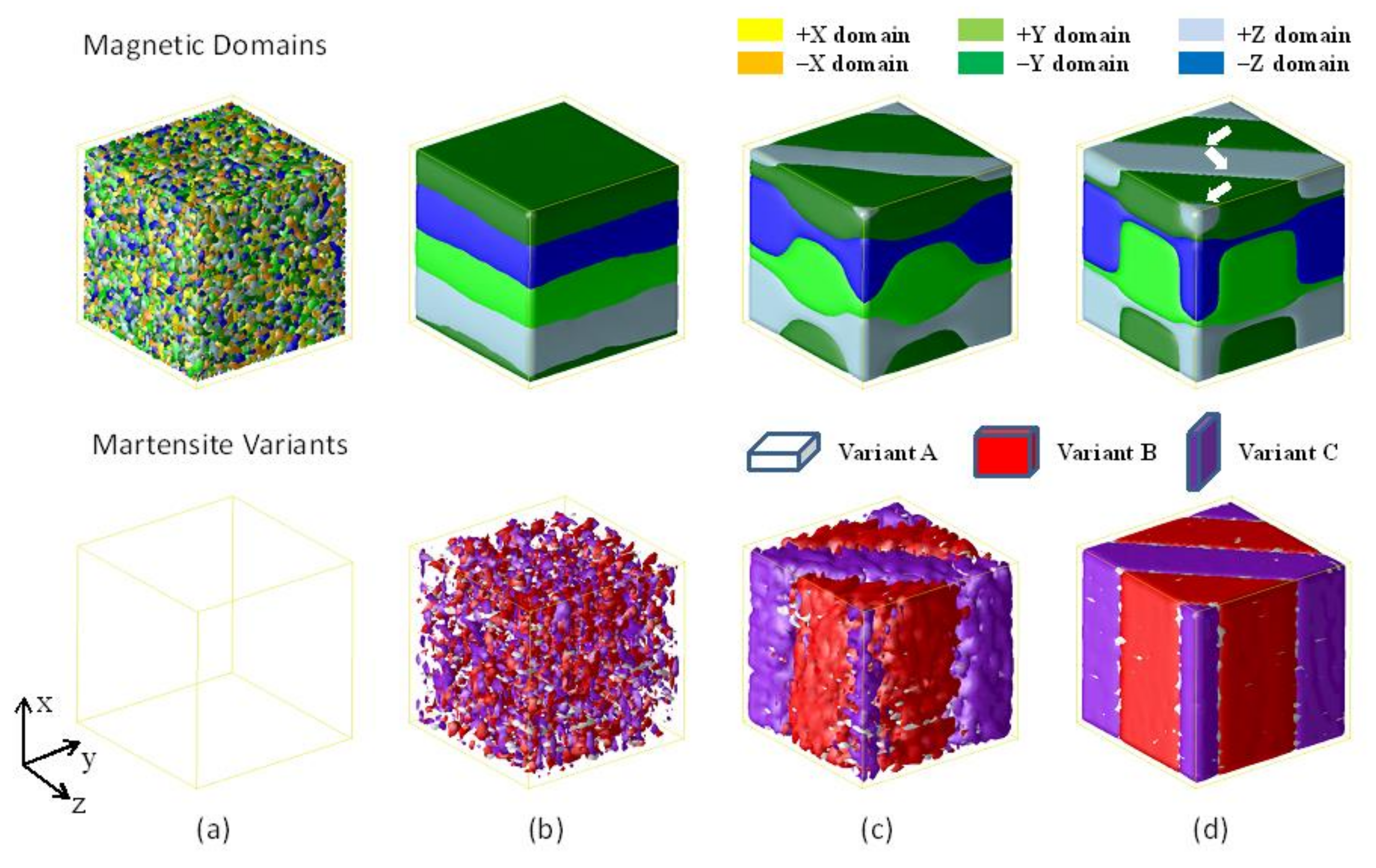
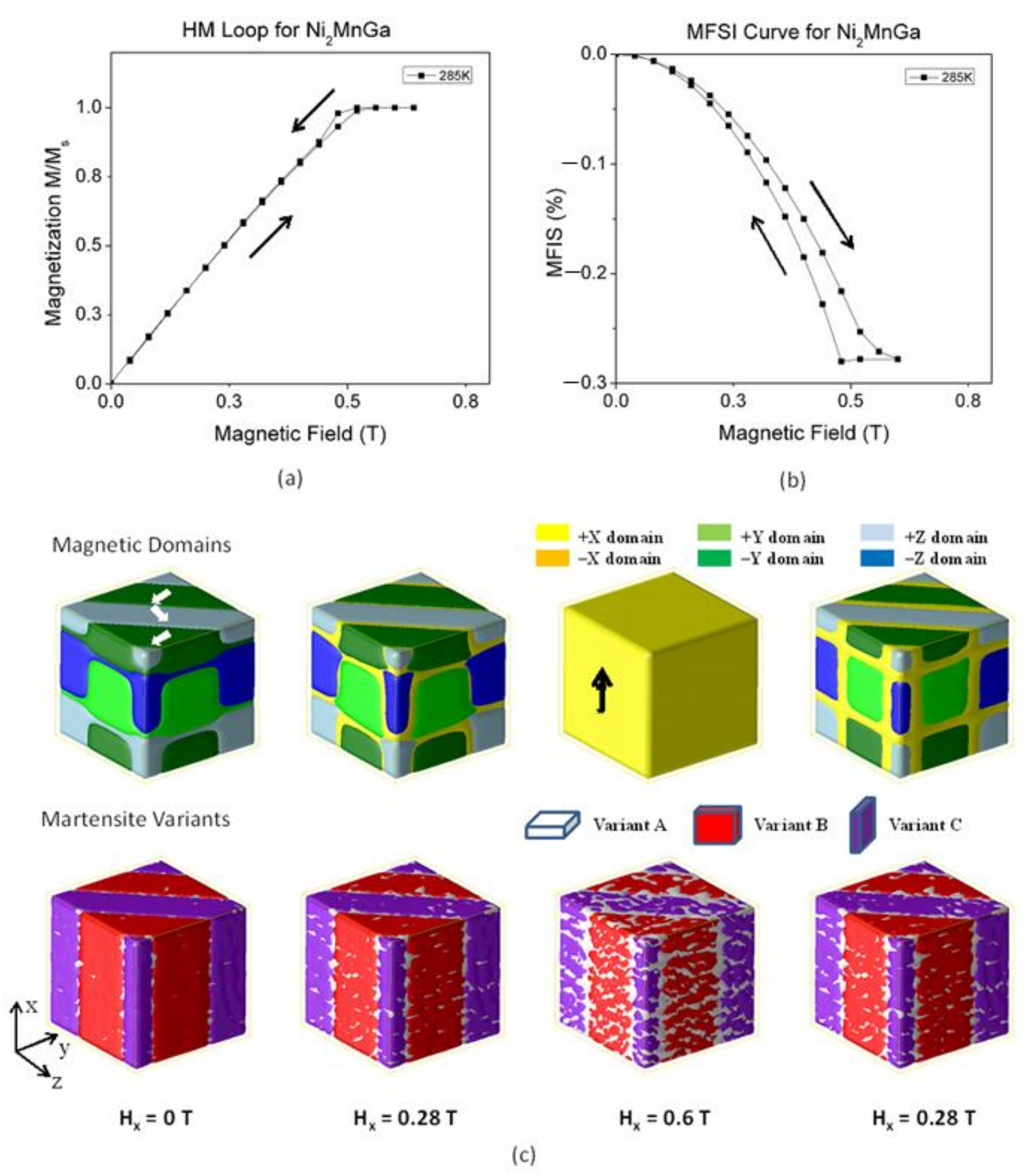
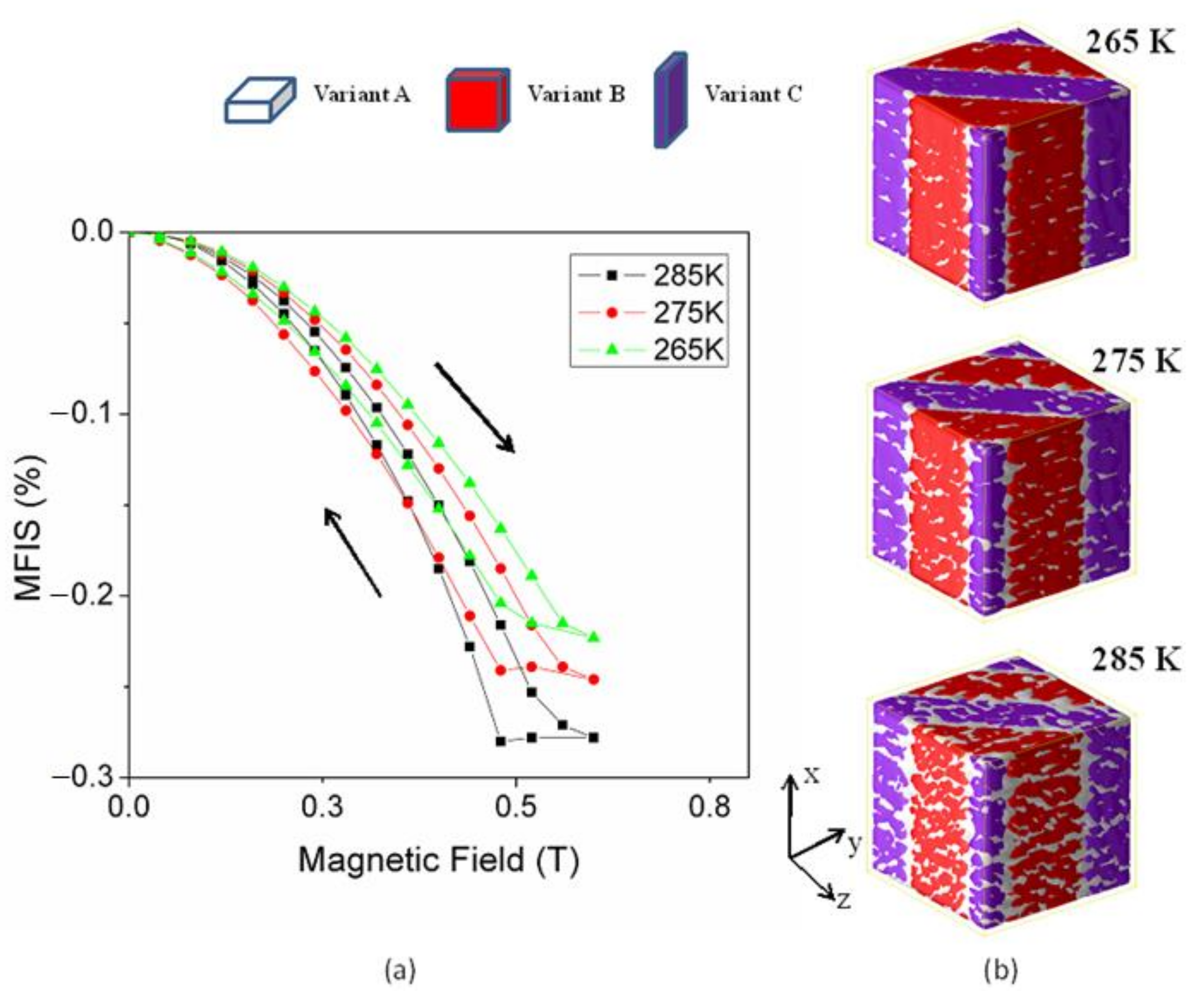
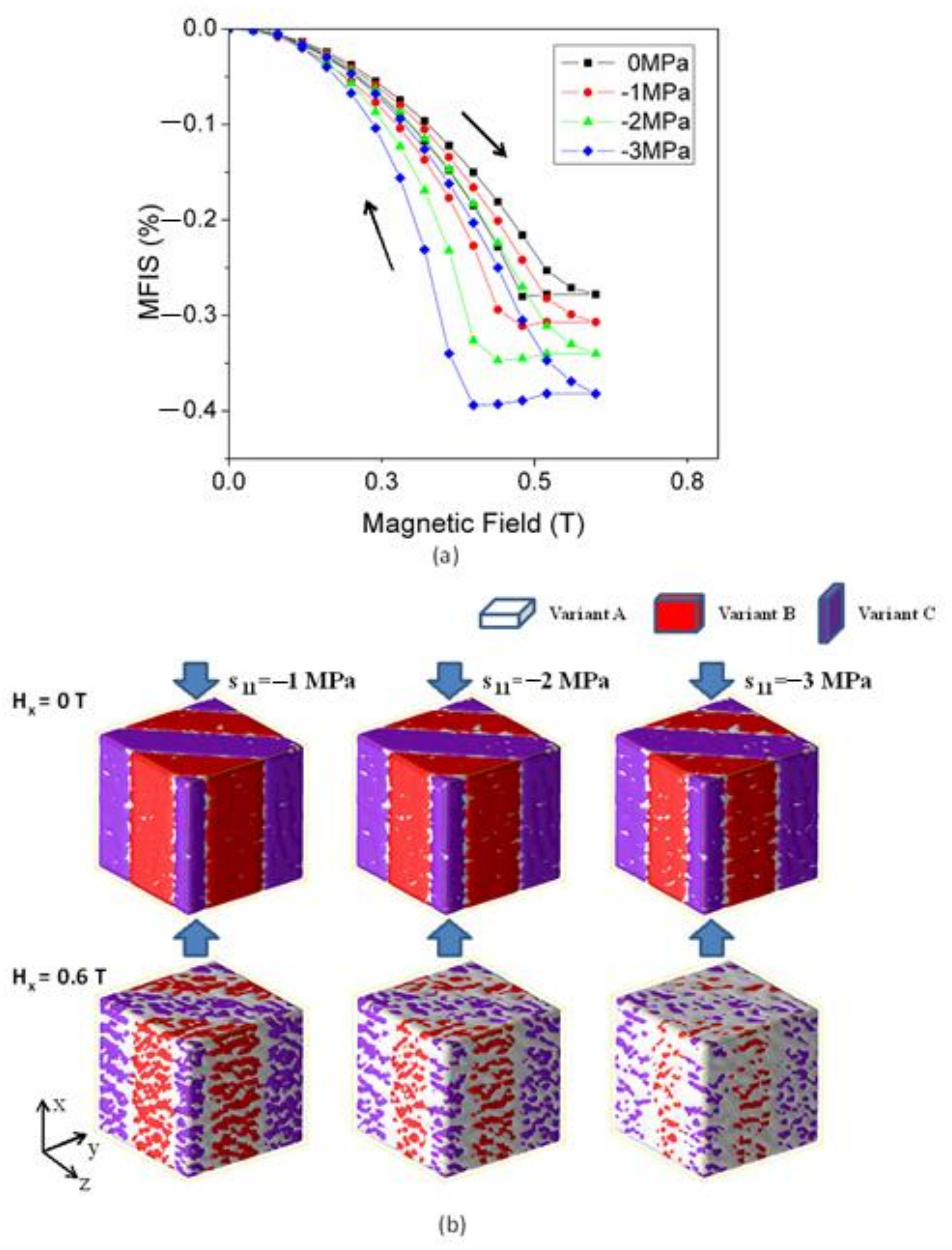
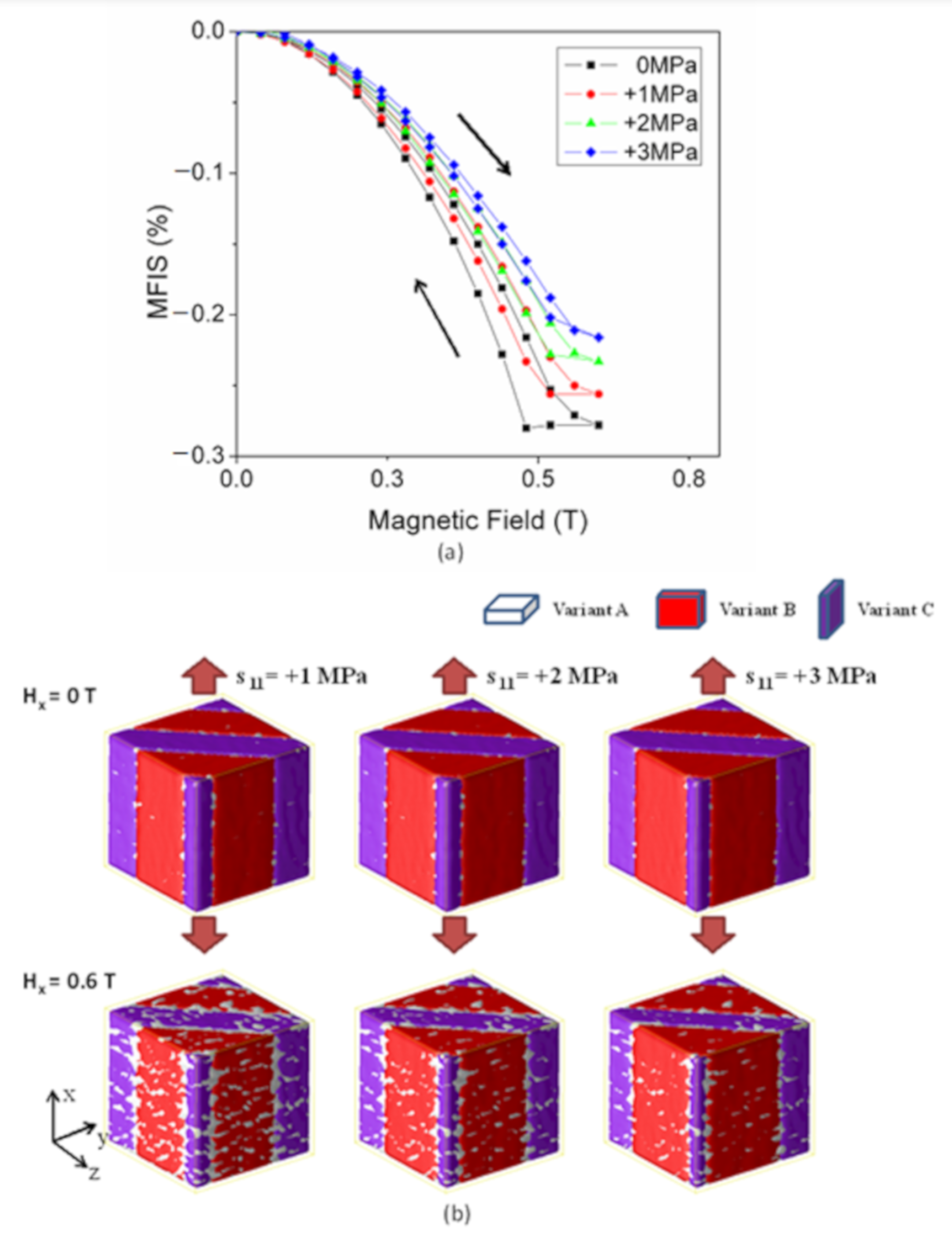
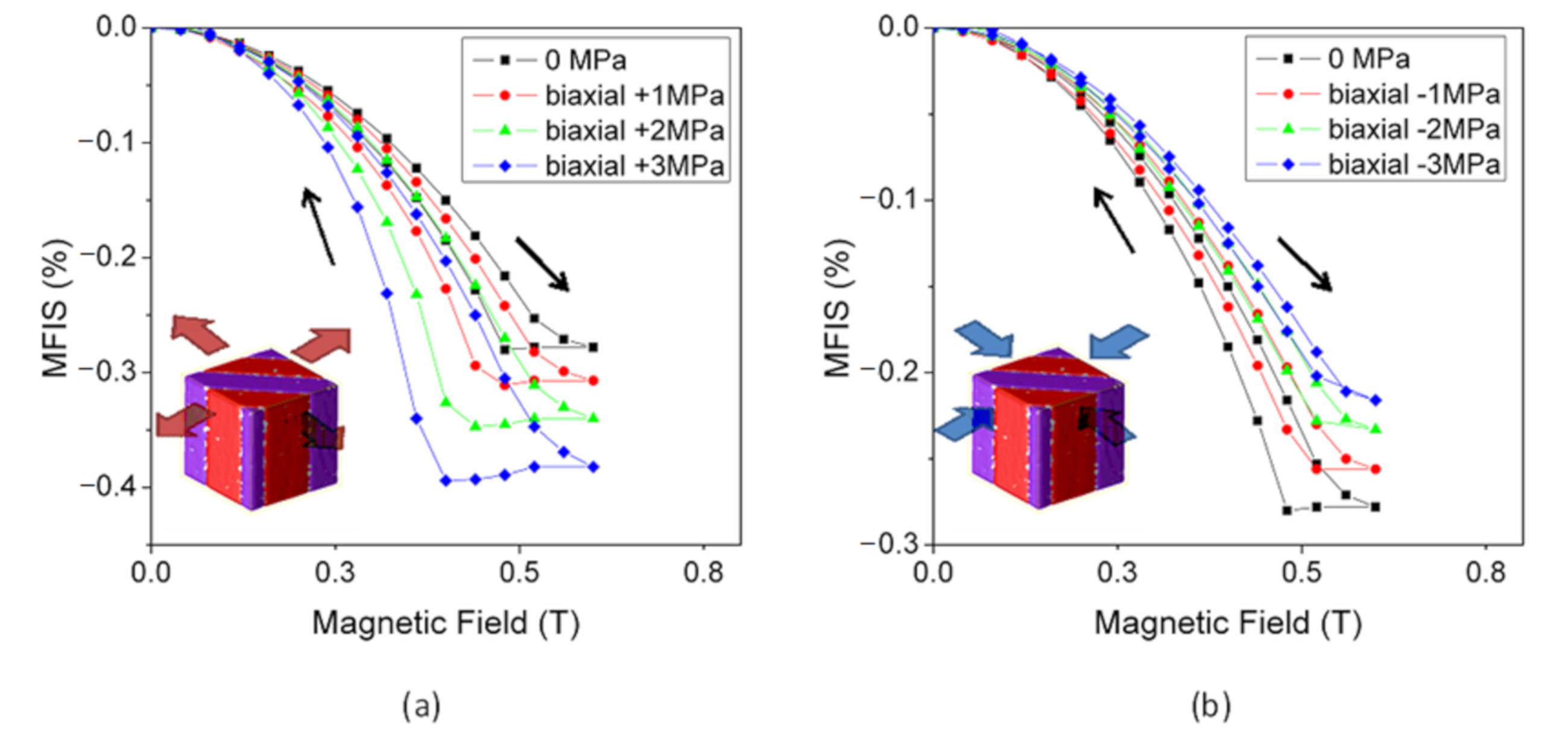
Publisher’s Note: MDPI stays neutral with regard to jurisdictional claims in published maps and institutional affiliations. |
© 2021 by the authors. Licensee MDPI, Basel, Switzerland. This article is an open access article distributed under the terms and conditions of the Creative Commons Attribution (CC BY) license (https://creativecommons.org/licenses/by/4.0/).
Share and Cite
Wu, P.; Liang, Y. Enhanced Reversible Magnetic-Field-Induced Strain in Ni-Mn-Ga Alloy. Metals 2021, 11, 2017. https://doi.org/10.3390/met11122017
Wu P, Liang Y. Enhanced Reversible Magnetic-Field-Induced Strain in Ni-Mn-Ga Alloy. Metals. 2021; 11(12):2017. https://doi.org/10.3390/met11122017
Chicago/Turabian StyleWu, Pingping, and Yongfeng Liang. 2021. "Enhanced Reversible Magnetic-Field-Induced Strain in Ni-Mn-Ga Alloy" Metals 11, no. 12: 2017. https://doi.org/10.3390/met11122017
APA StyleWu, P., & Liang, Y. (2021). Enhanced Reversible Magnetic-Field-Induced Strain in Ni-Mn-Ga Alloy. Metals, 11(12), 2017. https://doi.org/10.3390/met11122017





